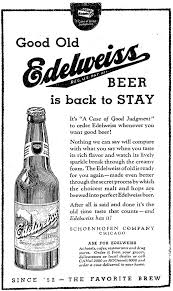In the United States, the year 1933 marked a significant turning point in the nation's history with regards to beer and alcohol. This was the year when Prohibition, the nationwide ban on the production, importation, transportation, and sale of alcoholic beverages that had been in effect since 1920, finally came to an end. The repeal of Prohibition brought about a momentous occasion for beer enthusiasts, as breweries could once again legally produce and sell beer. The reintroduction of beer into American culture in 1933 sparked a wave of celebration and marked the beginning of a new era in the country's relationship with alcohol. The 18th Amendment to the United States Constitution, which established Prohibition, had been met with mixed reactions since its ratification in 1919. While proponents of Prohibition argued that it would reduce crime, poverty, and social ills associated with alcohol consumption, the reality proved to be far more complicated. Prohibition led to the rise of illegal speakeasies, bootlegging, and organized crime, as well as a loss of tax revenue for the government. Moreover, many Americans continued to consume alcohol despite the ban, leading to widespread disrespect for the law. By the early 1930s, public sentiment had shifted decisively against Prohibition. The Great Depression exacerbated economic hardships across the country, leading many to view the legalization and taxation of alcohol as a potential source of revenue and employment. Additionally, the failure of Prohibition to achieve its intended goals became increasingly apparent, further eroding support for the ban. In 1933, newly elected President Franklin D. Roosevelt made the repeal of Prohibition a key priority of his administration. On March 22, 1933, Roosevelt signed the Cullen-Harrison Act into law, which amended the Volstead Act and legalized the sale of beer with an alcohol content of 3.2% by weight (or 4% by volume). This marked the first legal sale of alcoholic beverages in the United States since the enactment of Prohibition over a decade earlier. The end of Prohibition brought about a sense of jubilation and relief across the country. Breweries that had been shuttered for years resumed operations, and beer began flowing freely once again. The resumption of legal beer production and consumption had significant economic ramifications, creating thousands of jobs in brewing, distribution, and hospitality industries. The reintroduction of beer also had cultural and social implications. Beer became synonymous with relaxation, camaraderie, and celebration, as Americans flocked to bars, taverns, and breweries to enjoy their favorite brews. Beer gardens and outdoor festivals became popular destinations for socializing and entertainment, as people reveled in their newfound freedom to enjoy a cold beer in public. However, it's important to note that the repeal of Prohibition did not immediately solve all the problems associated with alcohol consumption. Regulation and enforcement of alcohol laws remained a complex and evolving issue, as states grappled with issues such as underage drinking, drunk driving, and alcohol-related crime. Nevertheless, the end of Prohibition in 1933 represented a significant milestone in American history. It marked the triumph of individual liberty and choice over government-mandated moralism, and it signaled a shift towards a more pragmatic and nuanced approach to alcohol regulation. Today, the repeal of Prohibition continues to be commemorated as a victory for freedom and democracy, and the availability of beer once again in 1933 stands as a symbol of resilience and progress in the face of adversity.
1933 U.S.A. Beer Available Again
